|
Prelude to Naval Actions in the Solomon Islands.
Admiral Isoroku Yamarnoto was the brilliant Commander- in- Chief of the Imperial Japanese Navy who, In February of 1941 ordered Rear Admiral Takijuro Onishi chief of staff to the 11th. Air Fleet to draw up a plan for a possible attack on the US Pacific Fleet at Pearl Harbor.
It was named Operation Hawaii or sometimes named Operation Z.
Pre dawn on the 7th. of December 1941, from the decks of six Japanese aircraft carriers 183 aircraft took to the air, consisting of high level bombers, torpedo carrying aircraft with their fighter escort A second wave of aircraft was ready to launch at 0705 ( 7.05 AM ) this flight did not contain any torpedo carrying aircraft
Without any declaration of war from Japan, both waves struck the totally unprepared US Fleet moored in Battleship row, or at Ford Island, and decimated the naval ships there.
The sole saving grace, the US Aircraft Carriers were at sea on an exercise routine, and thus were unscathed by this ignominious attack.
The United States now entered the war, the die was thus cast for the ultimate defeat of the Japanese Empire.
USS Phoenix at Pearl Harbor 7 December 1941. Post war sold to Argentina, renamed Belgrano, sunk by Royal Navy nuclear submarine HMS Conqueror, Falklands war, using a conventional torpedo.
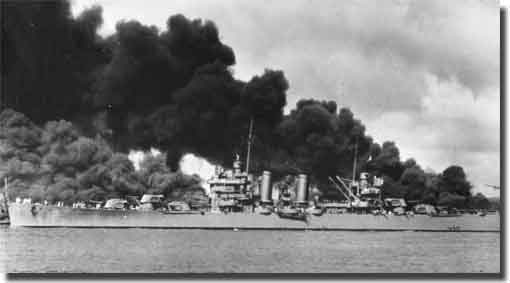 |
The Japanese Southwards Thrust.
Japanese forces now started their mad dash southwards, in December, they had invaded Northern Malaya, sunk the Royal Navy Battle Ship Prince of Wales, and the Battle Cruiser Repulse, leaving the gate to Singapore wide open.
The British Colony of Hong Kong fell on Christmas Day 1941. Japanese Forces Supreme early in 1942.
The unbelievable happened on the 15th. of February, the so called impregnable fortress of Singapore surrendered, with that capitulation, thousands of both British and Australians went into captivity, POW'S of the Japanese. Before the war's end, a large number were to die as they were forced to build the Infamous Burma Railway.
Also in February, the Japanese invaded the Dutch East Indies, they were after the oil available in this area.
At the Battle of Sunda Strait during this incursion by Japanese forces, both HMAS Perth and the US cruiser Houston were sunk.
USS Lexington at the Battle ofthe Coral Sea.
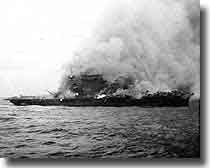 |
April found United States forces having to surrender to the Japanese at Bataan in the Philippines, and General Douglas MacArthur ordered out by his President escaped to Australia to head up the Allies forces in the South West Pacific.
He travelled by a PT boat to Darwin, then eventually arriving by train in Melbourne, he strode down the platform to meet the welcoming party, looking like a conquering hero and saviour of Australia, not at all like a defeated general.
It was his departure from the Philippines that coined the name to be used somewhat disparagingly by Australian service people in the future "Dug Out Doug."
Slowing up the Japanese Advance.
On the 3rd. of May 1942, the Japanese moved into the Solomon Islands area, and occupied Tulagi, and set up a sea plane base there, they were also planning to invade Port Moresby in New Guinea.
Two important Naval actions took place in the first half of 1942.
Burning Japanese Carrier Hiryu, 5 May 1942, Battle of Midway, she sank a few hours later
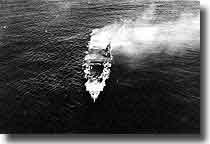 |
( a ) The Battle of the Coral Sea.
On the 7th. of May at the Battle of the Coral Sea, both the IJN and USN each lost an aircraft carrier. The former Shoho, and the latter Lexington, one might well list this action as a draw, but it was an important strategic victory for the Allies, as Port Moresby was saved from a seaward invasion, forcing the Japanese to plan to attack it overland, and it was in New Guinea that Australian troops stopped the Japanese for the first time. In due course, and after much bitter fighting, a combination of US and Australian troops won the battle for New Guinea.
( b ) The Battle of Midway.
He had assembled a huge fleet, 4 large and 2 medium aircraft carriers, 11 battleships, 16 cruisers , 55 destroyers backed up by submarines, they were meant to engage and destroy the US Pacific Fleet in its depleted form, and support the invasion of Midway. At the same time, the Aleutian Islands were to be assaulted by a second force of 2 carriers, 6 cruisers and 13 destroyers.
Japanese Carrier Shoho Battle of the Coral Sea
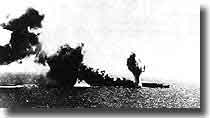 | Japanese Naval Code Broken.
The US Navy had broken the Japanese Naval Code and Admiral Nimitz was privy to Yamamoto’s plans at Midway, but all he could muster against the imposing Japanese force was 3 Carriers, 8 cruisers, 17 destroyers and some submarines.
Midway.
The Battle of Midway took place over 4/7 May, and proved the efficacy of the aircraft carrier and its planes, the two fleets did not actually come within sight of each other.
USS Destroyer Hammann torpedoed by Japanese Submarine At Midway, sinking bow first
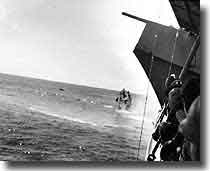 |
Midway was a decisive US victory, four Japanese carriers, Kaga, Akagi, Hiryu, and Soryu, were all sunk, as these had all been part of the Japanese Task Force that was used to attack Pearl Harbor, it was partial revenge for that unprovoked attack.
The Japanese could ill afford such carrier losses, and Midway affected the balance of Naval power in the Pacific.
The USN lost Yorktown, crippled by Japanese carrier aircraft, she was finished off with torpedoes from a Japanese submarine lurking nearby, the destroyer Hammann was sunk by a submarine, and a Fleet oiler was also a casualty.
USS Yorktown being abandoned, hit by 2 aerial torpedoes, she rolled over and sank May 7, at Battle of Midway
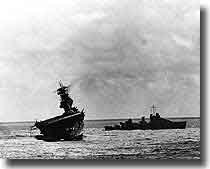 |
The US Navy by losing a carrier, was now down to three carriers in the Pacific Fleet, Saratoga, Enterprise and Hornet, a factor that weighed heavily on Vice Admiral Fletcher at Savo, but I am getting ahead of myself by several months. A fourth US carrier, Wasp, was at San Diego, having just arrived there from the Atlantic.
The island of Midway was saved, but the islands of Attu and Kiska in the Aluetian chain were seized by the Japanese, and occupied until the spring of 1943, this did not matter a great deal as it had little impact on the course of the war in the Pacific.
Japanese land on Guadalcanal.
Early in July of 1942, the Japanese landed on Guadalcanal, and commenced to build an airfield there.
Major Martin Clemens, a District Officer and Coast Watcher with his group of native scouts was alone on Guadalcanal behind enemy lines, he observed the haste of the Japanese to construct an airfield here, and using a heavy and very cumbersome teleradio, he transmitted a warning message to his Coastwatcher boss in Australia, Eric Feldt.
Major Martin Clemens Coastwatcher Guadalcanal. With a group of his scouts, Martin warned that that the Japanese were constructing an airfield there, this warning put in train Operation Watchtower. the US Marine landings in the Solomons August 1942
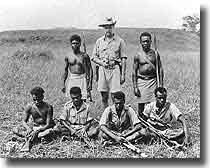 |
This report was soon relayed on to Washington DC.
The US Chief of Navy Operations, Admiral Ernest King USN, persuaded the US Joint Chiefs that now was the time to go on the offensive in the Pacific, he had some trouble gaining this approval, the US policy being to build up their forces in the United Kingdom, go after Hitler and Mussolini, and defeat them first before turning their fire power onto Japan in the Pacific war.
General Marshall wanted his Douglas MacArthur to take command in any invasion at Guadalcanal, but King, always very supportive of his Navy, and a fierce protagonist won out. He insisted it would be an US Navy show with Navy Marines, and put Admiral Chester Nimitz in overall command.
King also made sure MacArthur could not stick his nose into Operation Watch Tower, by moving his command of the South West Pacific Area westwards from 165 degrees East to 159 degrees East, Guadalcanal now fell within Admiral Nimitz’s Pacific Command.
Operation Watch Tower.
Admiral Chester Nimitz as C in C Pacific, had his area of operations stretch from the Aleutians to New Zealand, and his responsibilities sub-divided into North - Central and South Pacific.
On the 17th. of May 1942, Vice Admiral R.L.Chormley USN, had been given command of the South Pacific area.
Vice Admiral F.J. Fletcher USN was put in charge of the Expeditionary Force, although he had no previous experience of this type, and had two carriers sunk under him at Coral Sea and Midway, Lexington, and Yorktown.
From contemporary reports he appeared to be a very tired man at this time.
Rear Admiral Kelly Turner USN was named as Commander South Pacific Amphibious Forces, and when King told him he was to command amphibious forces for the landings at Tulagi and Guadalcanal, he protested that he did not have sufficient knowledge about amphibious warfare, King brushed his protest aside with: “ YOU WILL LEARN.”
Turner back in 1939, had been in command of the US cruiser Astoria, the then Japanese Ambassador to the US had died, and Astoria was given the task of carrying his ashes back to Japan.
We will learn more of Astoria at the Battle of Savo Island, soon to be unfolded.
The Royal Navy, Rear Admiral V.A.C.Crutchley, Victoria Cross, which he had won as a Lieutenant in WW1, was appointed to command the Naval Support Group and also be Turner's second in command.
Rear Admiral J.S.McCain USN was to command the Air Task Force ie. all water and land based aircraft in the South Pacific.
The Officer in command of the 1st. Marine Division, Major General A.A. Vandergrift was given the Joint Chief's directive by Ghormley " To seize Tulagi and adjacent positions and land on 1st of August 1942."
The other important member of the cast of Watch Tower, was the Japanese Commander of their 8th. Fleet, Vice Admiral Gunichi Mikawa, IJN.
It is interesting to note, that Collier, in his book: The War in the Far East 1941 - 45, said: The ensuing expedition to Guadalcanal and Tulagi, was the first sea - borne expedition to enemy - held territory by US Forces since 1898.
It also happened that Operation Watch Tower was the very first Allied offensive planned against the Japanese in the Pacific Theatre.
Not enough time for planning.
Vandergrift thought he was making it very clear to Admiral King that his Marines could not be ready to land on the 1st. of August, but King was adamant, the landings would soon go ahead, and he could only win a three day postponement.
Ghormley now added his voice in protest against this rush, with a further plea to Admiral King to grant more time to prepare, but was only able to gain a further three days more grace. “That was it! “ King stated, “ Dog Day” the 7th. of August was set for the landings, and it would not be altered again.
Expedition Composition.
( a ) Carrier Group. Vice Admiral Fletcher in Saratoga, commanding the total expedition. Rear Admiral L. Moyes in Wasp, Commander of the Air Support Force. The three carriers, Saratoga, Enterprise and Wasp, could provide 237 aircraft, of these 234, 98 fighters, 96 dive bombers, and 40 torpedo bombers were operational and ready to go when Dog Day dawned on the 7th. of August 1942.
This group was backed up with the new 35,000 ton battleship, North Carolina, 5 heavy cruisers, Minneapolis, New Orleans, Portland, Salt Lake City, and San Francisco, 1 light AA cruiser, Atlanta, and 16 destroyers.
( b ) Landing Group. Rear Admiral R.K. Turner in McCawley, Commander South
Pacific Amphibious Forces. 15 transports for Guadalcanal, 4 transports plus 4 destroyer transports for Tulagi.
Mayor General A. A. Vandergrift in command of about 18,000 Marines of the 1st. Marine Division and their equipment.
( c ) Naval Support Group under the command of Rear Admiral V. A. C. Crutchley VC, RN. ( flying his flag in the heavy cruiser HMAS Australia. ) 6 Heavy 8 inch cruisers:
HMAS Australia. Captain H.B. Farncomb RAN.
HMAS Canberra Captain F.E.Getting RAN.
USS Chicago. Captain H.A.Bode USN.
USS Astoria. Captain W.E.Greenman USN.
USS Quincy. Captain S.N.Moore USN.
USS Vincennes. Captain F.L.Riefkohl USN.
2 Light Cruisers. :
HMAS Hobart. Captain H.A.Showers RAN.
USS San Juan. Rear Admiral N. Scott USN.
8 Fleet destroyers for the fleet, Blue, Ralph Talbot, Patterson, Bagley, Helm, Wilson,
Buchanan, and Monssen.
7 destroyers to protect the transports.
( d ) Air Task Force. under the command of Rear Admiral J.S.McCain USN. Consisting of land based and water borne aircraft from the Army, Navy, Marines and RNZAF.
The real problem was that most of McCain’s land based aircraft were of short range, the B17’s had a 710 mile each way flight in daylight, to and from the Guadalcanal area.
Japanese Naval Forces.
After the Coral Sea and Midway battles, the Japanese were forced to decide that the only way they might reach Port Moresby was to attack it overland from Buna.
Vice Admiral Gunichi Mikawa IJN was given the command of the new 8th. Fleet, and he chose the heavy cruiser Chokai to hoist his flag on the 26th. of July 1942, he had 4 other heavy cruisers, 2 light cruisers, and destroyers as available to add to his command. He was based on Rabaul.
Raising the US colours on Guadalcanal after the initial landings on the 7th. of August 1942.
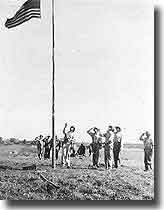 | Approach to Landing Area, and the 7th. of August Landings.
During the last two days of the invasion force approaching the Solomon Islands, we were assisted by both patchy rain and lowered visibility.
Over the dark period of the 7th. of August Admiral Fletcher and his carrier group were about 100 miles south of the proposed beachhead.At this time, I was serving in HMAS Canberra as a watchkeeping Sub-Lieutenant RAN, in June, I had been granted my watchkeeping ticket, which meant that my Captain G.D.Moore RAN, believed I was competent to be in charge of the ship on my own as the Officer of the Watch.
We now slipped past Cape Esperance and early in the morning of the 7th. of August, my ship was in her bombardment position. Suprise was complete! at 0613 ( 6.13 AM ) both air strikes by carrier aircraft, and the naval bombardment started.
All hell broke loose, as the Tulagi beaches were pounded with a withering fire, and all the Japanese seaplanes were caught on the water at Tulagi, and went up in flames.
On Guadalcanal, the Japanese retreated to the surrounding hills, but it was a different story here at Tulagi, the local defenders had no where to go, they stood and fought the invading Marines with desperation, and resisted any advance.
It took until the end of day 2 for the Marines at Tulagi to secure their landing positions and make any advances.
Operaltions on Guadalcanal following the landings on 7 August, 1942
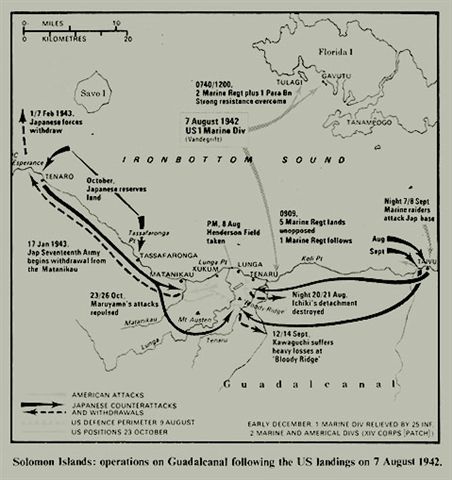 |
Japanese reaction.
It did not take long for the Japanese to react, at 1100 ( 11 AM ) we were warned over the Ship’s broadcast system to expect an air attack, and all hands should go to lunch early, to be ready for this onslaught.
Paul Mason, an Australian Coastwatcher hidden in the mountains SE of Bougainville, had broadcast this warning.
He was spot on, a desperate, and well pressed home attack was carried out by Japanese twin engined torpedo carrying Betty Bombers. 16 were shot down, and we lost 12 carrier borne aircraft. It was the first time that I had been subjected to an enemy air attack, I was staggered just how the Japanese Betty’s could fly through so much flak thrown up by the Fleet’s AA guns, and come through unscathed. I thought no aircraft could survive such a barrage, but they did, as on they came to drop a deadly torpedo at the last moment, then pull into a steep climb trying to escape and head for home, all very scary. It was fortunate at this early stage of the war against Japan, that the frightful weapon of the Kamikaze Aircraft had not been conceivedUS Destroyer Mugford was hit, with 22 of her crew dead.
Vice Admiral Mikawa sailed from Rabaul in Chokai with the light cruisers Tenryu, and Yubari plus the destroyer Yunagi, he was joined by 4 heavy cruisers from Kavieng, Aobe, Kako, Kinugasa and Furutaka, to form a formidible strike force that now proceeded south at high speed.
I find it interesting that this Japanese force of 7 cruisers, 5 heavy, and 2 light would proceed as a group with but a single destroyer. No Allied cruiser group of those numbers would ever venture off on a strike operation without at least several screening destroyers.
I guess that after several years of war we had been subjected to attacks from a very determined and efficient U-Boat arm of the German Navy, and had learned in those circumstances that it was mandatory to have your destroyers in sufficient numbers to help protect the main fleet. It was a different war in the Pacific, certainly the numbing cold of a North Atlantic winter was never present here, but I digress.
Sighting of Japanese cruiser force.
A B17 aircraft from MacArthur’s command sighted part of this group, and Lieutenant Commander Munson USN in his submarine S38, sighted Mikawa and his ships in the St. Georges Channel sailing SE, he reported 2 destroyers and 3 large unknown ships, he was so close he could not squirt off any torpedoes at these ships.
McCain had been asked by Turner to schedule a Catalina aircraft to search to the NW, the area where any enemy attack was likely to eventuate from, not only did McCain not send out this aircraft, but much worse, he did not inform Turner that he had not ordered this flight, so, quite naturally Turner assumed no threat was developing to his landing operations from that area.
Night Dispositions over the 7th/8th. of August.
Savo Island squats outside of Guadalcanal, leaving both a southern and northern entrance to the open water that leads to the landing beaches where the transports were still unloading the heavy equipment of the Marines and their ammunition and food supplies.
Australia, Canberra and Chicago with 2 destroyers, Patterson and Bagley, were placed to block the Southern entrance between Savo and Guadalcanal.
Between Savo and Florida to the north, 3 US heavy cruisers, Astoria, Quincy and Vinvennes with their 2 destroyers Wilson and Helm were deployed to guard this entrance.
The Australian light cruiser Hobart, and the US light cruiser San Juan with the destroyers Buchanan and Monssen blocked the gate at the Eastern entrance.
The two best radar and anti-submarine operating destroyers from the US Destroyer Squadron had been selected to carry out both the vital and important task of gate keeping to seawards to the west of Savo.
Blue and Ralph Talbot, were stationed to provide the three guarding groups of cruisers and destroyers with an early warning of the approach of any Japanese ships.
Well that was the plan, and these two destroyers were expected to stay alert and operate efficiently.
This night passed without incident.
Henderson Field in August 1942, taken from a Saratoga plane
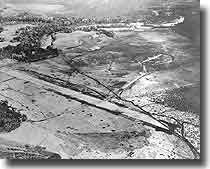 | Saturday the 8th of August.
The marines had achieved their objective on Guadalcanal, and had captured the airfield, now named Henderson Field.
We had another torrid day in the supporting ships, more hard pressed torpedo attacks from 40 Japanese twin engined Betty type bombers, with 17 of them downed.
At one stage I could count 6 blazing aircraft crashed in the surrounding waters, and the destroyer Jarvis was torpedoed, a blazing aircraft crashed into the transport George F. Elliot, which had to be abandoned, and then grounded south of Florida Island.
Hudson Aircraft sight Japanese Task Force.
An Australian Hudson aircraft flying out of Milne Bay in New Guinea sighted Mikawa and his force at 1025 ( 10.25 AM ) on the 8th. of August, their radio report was not acknowledged at base ( it later was learned that at the time of the report an air attack had closed down the radio station at Milne Bay )
Sergeant Bill Stutt flew his aircraft the long trip home, landed, and immediately was debriefed, reporting they had sighted 3 cruisers, 3 destroyers, and 2 seaplane tenders or gunboats on a course of 120 degrees, at a speed of 15 knots.
A second Hudson also saw Mikawa and on landing at base reported 2 heavy cruisers, 2 light cruisers, and a small unidentified vessel.
Back at his headquarters in Australia, MacArthur thought this force heading on a course of 120 degrees was most probably moving to the Shortlands to set up a seaplane base there, Turner believed they were moving to Rekata Bay on St.Isabel Island. Only the day before, an aircraft from the carrier Wasp had shot down a Japanese seaplane north of Rekata Bay. Mistaking some of the ships sighted to be seaplane carriers, and then deciding these ships were heading to set up a new seaplane base was to prove unfortunate and costly in the long run.
Laying the blame on the Hudson crew.
The American Naval Historian Morison layed blame on the Hudson crew, he reported that they did not break radio silence to report their sighting, took their time flying back to base, had tea before debriefing etc. Many books written about Savo slavishly followed Morison’s lead and a stigma hung over the Australin Hudson crew led by Bill Stutt for many years.
Many years later, with Bruce Loxton, the author of The Shame of Savo, ( Bruce was a Midshipman in Canberra at Savo, and was badly wounded ) we interviewed Stutt and his Navigator, they confirmed they tried to report their sighting, hurried back to base and immediately debriefed, and that Morison’s report was nonsense.
Finally, a copy of a report from Chokai, which recorded that Stutt’s signal report to his base had been intercepted, and read, in Mikawa’s flagship, was unearthed in Japan. At long last Bill Stutt and his Hudson crew were vindicated, and Morison’s myth was finally laid to rest.
Mikawa launches 45 seaplanes.
5 seaplanes were launched from Mikawa’s cruisers to fly over Guadalcanal and its surrounding waters, they reported a count of all the Allied ships at Tulagi and Guadalcanal, but, best of all, no report of any sighting of US carriers.
Mikawa decided to steam his force through “The Slot,” the strait between New Georgia and St. Isabel Islands, to arrive off Savo by 0130 ( 1 AM ) on the 9th. of August.
Night Stations 8th./ 9th. August.
The same night stations were assumed for the night of the 8th. / 9th. of August as were steamed on the previous night.
Fletcher departs with his Carriers.
At Koro during a dummy run of the landfing craft prior to the actual landings, Fletcher had assured Turner he would stay and cover the landing beaches with carrier aircraft for 3 days, Turner had pleaded for a longer coverage, indicating he thought he need 5 days to unload all the heavy equipment etc for the Marines.
But Fletcher was adamant, and in the absence of his boss Ghormley, his view prevailed. But soon after we assumed our night stations, Turner read a message from Fletcher to Vice Admiral Ghormley, indicating that his fighter numbers were down, and his fuel was running low, and asking approval to withdraw his carriers.
In fact, he took off immediately, without approval, without even telling Turner directly that he was leaving the landing area with his Carrier group. He was gone, having lost a carrier at Coral Sea, another at Midway, there was no way that Vice Admiral Fletcher was going to risk losing his third carrier.
“HE WAS OUT OF THERE!” after promising to support the landings with air cover for three days, Fletcher was gone after but 2 days, the landing area, the transports, the supporting warships, all bereft of any air cover, Turner was appaled.
Later, an examination of the ship’s logs revealed that fuel was not running low, the Japanese had in fact never sighted the carrier force at all, so there appeared to be little threat from them.
Morison’s verdict on this desertion by Fletcher was:“ His force could have remained in the area with no more severe consequences than sunburn.”
At least, in my view, Morison got that right!
Turner calls a meeting at Guadalcanal.
As I have indicated, Turner was most concerned at the departure of the Carriers, which he now believed put the transports and their supporting ships at high risk. He summoned both Rear Admiral Crutchley, and Major General Vandergrift to his flagship, Mc Cawley to a meeting to discuss the situation that had now developed. As Crutchley had some 20 miles to cover to obey his summons, he decided to pull Australia out of the line and at 2055 ( 8.55 PM ) he left to proceed to the meeting.
Turner informed his colleagues due to Fletcher’s departure, he intended to withdraw all surface forces at 0730 ( 7.30 AM ) on the 9th of August.The sighting of Mikawa’s force was discussed but Turner believed it’s destination was Rekata Bay.
This left Captain Bode in Chicago, in command of the southern force, at the time Canberra was leading Chicago, Bode decided he would stay where he was, and would exercise his command from the rear rather than take over the lead role.
Middle Watch.
As the clock ticked over at midnight, and the 8th. of August became the 9th. of August, I had already taken over my duties on Canberra’s bridge as Officer of the Watch. Sub Lieutenant Royce Dawborn, in handing over the watch told me: Our course was 120 degrees, speed 12 knots, reversing that course each hour by turning to starboard without any signal. Chicago was 600 yards astern, Patterson and Bagley our escorting destroyers, 45 degrees on our port and starboard bow respectively, at a distance of 1,000 yards.
The ship was in the 2nd. degree of readiness with 2 by 8 inch turrets, A and X manned, plus one 4 inch gun crew on both port and starboard sides closed up at their guns, but the guns were not loaded.
In the case of the main armament, there is a choice of using High Explosive or Semi Armour Piercing shells, the former used when bombarding, and in some cases against aircraft, the latter in a ship to ship engagement, when it is planned for the shell to pierce a ship's side or superstructure and then explode. To load either type takes very little time and will be done on the order of the Gunnery Officer or the officer fulfilling his role.
We also had part Damage Control Teams in place.
Finally, before leaving the bridge, Dawborn had told me that aircraft engines had been heard overhead in his watch, and the Captain had been informed.
Lieutenant Commander E. J. Wight was the Principal Control Officer on the bridge, both the Captain and Navigator were also present when I took the watch, but soon left to get some rest in their sea cabins.
The ship with all her crew had spent a gruelling two days, closed up at action stations over many hours, waiting for Japanese air attacks, and repelling them on arrival. Sleep had been a luxury, and was at an absolute premium.
The Weather.
Rain almost cloaked Savo Island from view, mist hung in the air, no moon was visible, and a light NE wind slowly moved low lying cloud, thunder rolled across the sky. I felt a feeling, almost of foreboding in the heavy, oppressive atmosphere.
At 0100 ( 1 AM ) at the transport end of our patrol we duly altered course 180 degrees to starboard to take up our course of 310 degrees for the next hour.
Aircraft engines were heard over us, and the Captain was called to inform him. ( It was subsequently learned that two seaplanes had been catapulted from 2 of the Japanese cruisers to reconnoitre the area, and when required, drop flares to illuminate the scene)
About this time, Mikawa in Chokai, was heading for the middle of the 7 mile gap between Savo and Guadalcanal, he was leading his 6 other cruisers with the destroyer as tail end Charlie on a course of 120 degrees at a speed of 25 knots. This pack of dingoes was heading for the unsuspecting sheep.
|